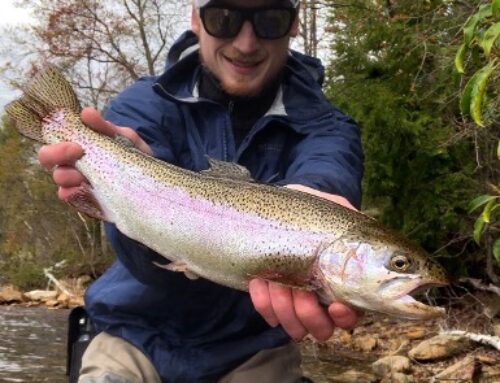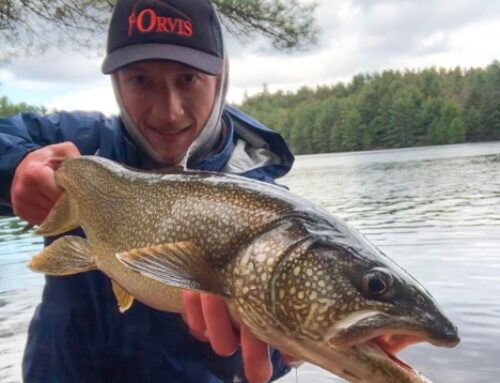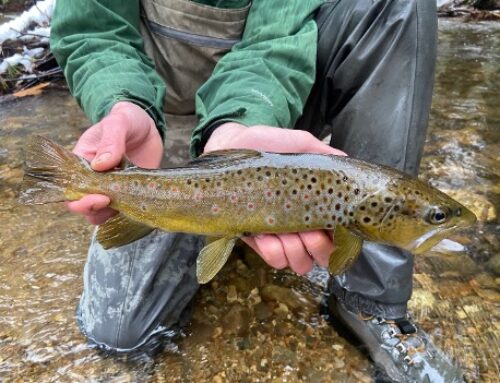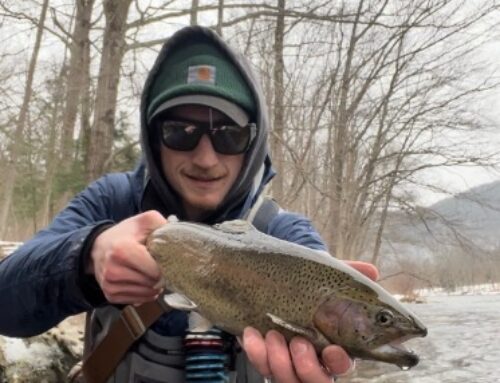Forgive me, fly-fisherpeople, for I have been remiss. It’s been way too long since the last report. Since then, it’s been a bit of a crazy fall: a little snow, some temps in the 20s and a week of sunny weather in the 70s in November. Or maybe that’s just a typical autumn in New England.
There are several fly tying classes coming up at the Deerfield Fly Shop, and what’s even better, they are all free! On Dec. 8, there will be an introduction to fly tying class for those with little to no experience. On Dec. 9 is the follow up class to the introduction for those beginners who want to take the next step. And for intermediate and advanced tyers, we will be offering a basic introduction to tying articulated streamers on Dec. 17–this class will be held virtually on Zoom. Check out the events page on our website for more details.
Water temps on the Deerfield River have dipped into the low 40s so we are definitely in cold weather mode now. The trout have mostly moved into their winter lies in slower, deeper water. That said, you can still find some fish actively feeding in the faster moving riffles, especially on warmer days. By and large much of your effort should be focused on getting flies deep in the slower moving water.

This is a great time of year to fish streamers. The browns are in spawn mode and so tend to be a bit more aggressive. I like to fish bigger articulated streamers, knowing that I will likely catch fewer fish but the possibility of a real bruiser is there. Rich Strolis’s patterns, which we have an ample supply of in the shop, are always effective. I vary the color and profile of the fly, as well as where I fish it in the water column and how I retrieve it. You can also have great success swinging woolly buggers and other smaller streamers. Streamer fishing for me is all about mixing things up until you hit on the right combination.
Nymphing is the best option to catch a larger quantity of fish and at times quality of fish–some of my biggest nymph-caught trout have come this time of year. Generally you want to get down deep and fish the slower edges of moving water or the deeper pools. I find indicator style nymphing to be most productive here but tightline techniques will also produce. As far as bugs go, standard Deerfield River patterns work well: bigger stoneflies like Pat’s Rubber Legs, Pheasant Tails, Hare’s Ears, caddis larvae, and some smaller maylfy nymphs in 18 to 22 to imitate the BWOs will all work. Junk flies are also a good bet this time of year: squirmies, mops, and, most importantly, eggs. In fact, I almost always have an egg on as one of my flies from October through the spring.
The Swift River is fishing very well and, for me, this is by far the best time to be on that crowded body of water. Browns and brookies are on their beds and the rainbows line up below to eat all the eggs that spill out. Junk flies, with eggs at the top of the list, are most effective but small orange soft hackles have been working and the midge game is always on at the Swift.

Area freestones like the Westfield, Millers and North are also fishing pretty well right now. Here I would use smaller streamers or nymph the deeper, slower water. It can be a bit hit or miss, but you can have some success as long as you get out there!
It’s game on for pike fishing. This is one of the best opportunities to get one of these apex predators on the fly as they tend to move into shallower waters in the fall and early winter. Best bets are in the Oxbow and Barton’s Cove on the Connecticut River.

Happy Thanksgiving everyone! We hope you can all find a way to enjoy it in these strange times. We will be closed Thanksgiving Day but open during our regular business hours the rest of the week.
Guided trips and lessons available. Call us at 413-397-3665 or email brian@deerfieldflyshop.com.
Dries: Midges, BWOs in 20 to 22
Nymphs: Pat’s Rubber Legs, Golden or Black Terminator Stone 8-12, eggs, hares’ ears 12-18, Pheasant Tail Nymphs 12-18, Frenchies 12-16, Zug Bugs 12-14, Stalcup’s Gilled Nymph 14, Tan/Olive Mops, Squirmies, Natural/Olive Caddis Pupae/Larvae 12-16, Red/Copper Johns 12-16, Sexy Walt 12-16.
Streamers: Woolly Buggers Olive/Black 6-10, White/Olive Sculpzilla 8,Bank Robber 2, Mini Headbangers, Alter Egos, Silly Rabbits, Complex Twist Bugger, Heisenberg Baby Bow/Cowboy/White 6, Sculpin Bunny, Black/Brown Rubber Bugger 4, Olive and Gold/White Mini Drunk & Disorderly.
Water Flows for Fife Brook Dam can be found here
Water release schedule for the next day is posted after 5pm. Check again before you head to the river. Minimum Flow 130 CFS (Cubic Feet/Second). Ideal for wading and Dry Fly Action. Normal Release 800-1,000 CFS
For Miller’s River in Erving here
For Miller’s River Bear’s Den area here
For East Branch of the Westfield here

